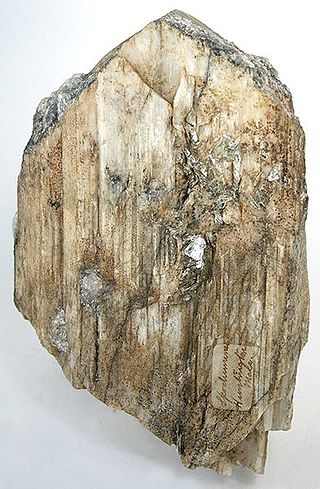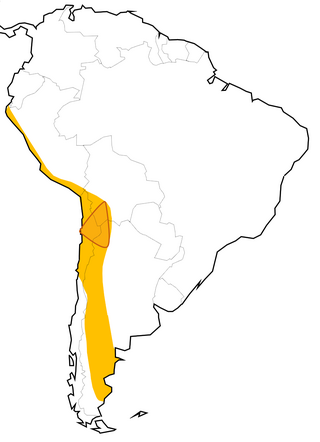Related Research Articles

Lithium is a chemical element; it has symbol Li and atomic number 3. It is a soft, silvery-white alkali metal. Under standard conditions, it is the least dense metal and the least dense solid element. Like all alkali metals, lithium is highly reactive and flammable, and must be stored in vacuum, inert atmosphere, or inert liquid such as purified kerosene or mineral oil. It exhibits a metallic luster. It corrodes quickly in air to a dull silvery gray, then black tarnish. It does not occur freely in nature, but occurs mainly as pegmatitic minerals, which were once the main source of lithium. Due to its solubility as an ion, it is present in ocean water and is commonly obtained from brines. Lithium metal is isolated electrolytically from a mixture of lithium chloride and potassium chloride.

Lithium carbonate is an inorganic compound, the lithium salt of carbonic acid with the formula Li
2CO
3. This white salt is widely used in processing metal oxides. It is on the World Health Organization's List of Essential Medicines for its efficacy in the treatment of mood disorders such as bipolar disorder.

Geothermal energy is thermal energy extracted from the Earth's crust. It combines energy from the formation of the planet and from radioactive decay. Geothermal energy has been exploited as a source of heat and/or electric power for millennia.

Spodumene is a pyroxene mineral consisting of lithium aluminium inosilicate, LiAl(SiO3)2, and is a commercially important source of lithium. It occurs as colorless to yellowish, purplish, or lilac kunzite (see below), yellowish-green or emerald-green hiddenite, prismatic crystals, often of great size. Single crystals of 14.3 m (47 ft) in size are reported from the Black Hills of South Dakota, United States.

The Salton Sea is a shallow, landlocked, highly saline body of water in Riverside and Imperial counties at the southern end of the U.S. state of California. It lies on the San Andreas Fault within the Salton Trough, which stretches to the Gulf of California in Mexico.

The Imperial Valley of Southern California lies in Imperial and Riverside counties, with an urban area centered on the city of El Centro. The Valley is bordered by the Colorado River to the east and, in part, the Salton Sea to the west. Farther west lies the San Diego and Imperial County border. To the north is the Coachella Valley region of Riverside County, which together with Imperial Valley form the Salton Trough, or the Cahuilla Basin, also the county line of Imperial and Riverside counties, and to the south the international boundary with Mexico.
Berkshire Hathaway Energy is a holding company and subsidiary of Berkshire Hathaway, which owns 92% of the company. Berkshire has owned a controlling stake since 1999. The company also controls power distribution companies in the United Kingdom and Canada. The remaining 8% is owned by the family of Walter Scott Jr.

Sociedad Química y Minera de Chile (SQM) is a Chilean chemical company and a supplier of plant nutrients, iodine, lithium and industrial chemicals. It is the world's biggest lithium producer.

Geothermal energy was first used for electric power production in the United States in 1960. The Geysers in Sonoma and Lake counties, California was developed into the largest geothermal steam electrical plant in the world, at 1,517 megawatts. Other geothermal steam fields operate in the western US and Alaska.
Allkem Limited, known as Orocobre Limited until 30 November 2021. Headquartered in Buenos Aires, Argentina, Allkem's portfolio includes lithium brine operations in Argentina, a hard-rock lithium operation in Australia and a lithium hydroxide conversion facility in Japan. Allkem is dual listed on the Australian Securities Exchange and Toronto Stock Exchange. In May 2023, Allkem agreed terms to merge with Livent. In January 2024, Allkem and Livent merged to form the NYSE-listed Arcadium Lithium.

Imperial Valley Geothermal Project is a complex of eleven geothermal power stations located in the Salton Sea Geothermal Field, along the southeastern shore of the Salton Sea in the Imperial Valley of California. It is the second largest geothermal field in the United States after The Geysers in Northern California.
The Thacker Pass Lithium Mine is a lithium clay mining development project in Humboldt County, Nevada, which is the largest known lithium deposit in the US and one of the largest in the world. There has been significant exploration of Thacker Pass since 2007. The Bureau of Land Management issued a Record of Decision approving development of the mine in January 2021. Construction began in March 2023 after an emergency appeal was denied by the court. The project site would cover 18,000 acres (7,300 ha), with less than 6,000 acres (2,400 ha) of that being mined, on a site 21 miles (34 km) west-northwest of Orovada, Nevada within the McDermitt Caldera. The mine is a project of Lithium Nevada, LLC, a wholly owned subsidiary of Lithium Americas Corp. In late January 2023, car giant General Motors announced it would invest $650M in the mine project, giving GM exclusive access to the first phase of production. In February 2023, when the initial $320 million investment was completed, GM became Lithium Americas largest shareholder and offtake partner. At full capacity the mine would produce 66,000 tons annually, equivalent to 25% of the current (2021) demand for lithium globally, which is expected to triple over the next five years. Development of the mine is driven by increasing demand for lithium used in electric vehicle batteries and grid storage of intermittently generated electricity from sources such as solar power or wind power.
Bromine production in the United States of 225,000 tonnes in 2013 made that country the second-largest producer of bromine, after Israel. The US supplied 29 percent of world production. Since 2007, all US bromine has been produced by two companies in southern Arkansas, which extract bromine from brine pumped from the Smackover Formation. At an advertised price of US$3.50 to US$3.90 per kg, the US 2013 US production would have a value of roughly US$800 million.
Brine mining is the extraction of useful materials which are naturally dissolved in brine. The brine may be seawater, other surface water, groundwater, or hyper-saline solutions from several industries. It differs from solution mining or in-situ leaching in that those methods inject water or chemicals to dissolve materials which are in a solid state; in brine mining, the materials are already dissolved.
Petrolithium is lithium derived from petroleum brine, the mineral-rich salt solution that is brought to the surface during oil and gas production and exploration.

The Lithium Triangle is a region of the Andes that is rich in lithium reserves, encompassed by the borders of Argentina, Bolivia, and Chile. The lithium in the triangle is concentrated in various salt pans that exist along the Atacama Desert and neighboring arid areas, the largest areas three main salt pants that define its vertex< Salar de Uyuni in Bolivia, Salar de Atacama in Chile, and Salar del Hombre Muerto in Argentina. Of those, Salar de Atacama in Chile has the highest concentration lithium among all world's brine sources. The shape of the area of interest for lithium resources in salt pans is however not a triangle but more of a crescent starting with Salar de Surire in the north and ending with Salar de Maricunga in the south. Because of this it has been proposed to rename the area Lithium Crescent.

Cornish Lithium is a mineral exploration and development company based in Cornwall, United Kingdom. The company was founded by Jeremy Wrathall in 2016.
Vulcan Energy Resources is a lithium and renewable energy producer, specializing in the production of lithium with a net-zero carbon footprint.
References
- ↑ Bernick, Michael (December 12, 2023). "The Jobs Perplex Of The Lithium Valley". Forbes. Archived from the original on February 5, 2024. Retrieved February 5, 2024.
- ↑ Fernández, Caleb J. (August 31, 2021). "Lithium fuels hope for Salton Sea". KYMA. Associated Press. Archived from the original on September 4, 2021. Retrieved September 4, 2021.
- ↑ Alistair MacDonald and Jim Carlton. (February 8, 2022). "Where Is There More Lithium to Power Cars and Phones? Beneath a California Lake.". Wall Street Journal Archived May 21, 2023, at the Wayback Machine Retrieved February 9, 2022.
- ↑ Ferry, Tim (November 29, 2023). "'Once in a generation' | US confirms huge lithium deposits in California's Salton Sea". Recharge | Latest renewable energy news. Archived from the original on January 28, 2024. Retrieved February 5, 2024.
- ↑ Characterizing the Geothermal Lithium Resource at the Salton Sea. . 2023-11-22. LBNL Report. 350. P. Dobson, Araya, N., Brounce, M., Busse, M.M., Camarillo, M.K., English, L., Humphreys, J., Kalderon-Asael, B., Mckibben, M.A., Millstein, D., Nakata, N., O'sullivan, J., Planavsky, N., Popineau, J., Renaud, T., Riffault, J., Slattery, M., Sonnenthal, E., Spycher, N., Stokes-Draut, J., Stringfellow, W.T., White, M.C.A. . https://escholarship.org/uc/item/4x8868mf Archived January 24, 2024, at the Wayback Machine .
- 1 2 Scheyder, Ernest (October 5, 2022). "U.S. steps away from flagship lithium project with Buffett's Berkshire". Reuters. Archived from the original on December 2, 2023. Retrieved October 6, 2022.
- ↑ Olalde, Mark (September 30, 2020). "Gov. Gavin Newsom signs off on new commission to study Salton Sea lithium extraction". The Desert Sun. Archived from the original on October 1, 2020. Retrieved September 30, 2020.
- ↑ "Lithium will fuel the clean energy boom. This company may have a breakthrough". Los Angeles Times. October 14, 2019. Archived from the original on February 16, 2024. Retrieved February 7, 2020.
- ↑ "California needs clean energy after sundown. Is the answer under our feet?". Los Angeles Times. January 22, 2020. Archived from the original on February 5, 2024. Retrieved February 7, 2020.
- ↑ Cohen, Ariel (July 26, 2021). "General Motors Moves To Secure Its Own Critical Mineral Supply Chains". Forbes. Archived from the original on February 5, 2024. Retrieved July 28, 2021.
- ↑ Abuelsamid, Sam (July 2, 2021). "GM Invests In Controlled Thermal Resources For U.S. Lithium Production". Forbes. Archived from the original on September 4, 2021. Retrieved September 4, 2021.
- ↑ Dunn, Jason. "GM changes strategy in the scramble for secure battery and chip supply". Automotive Logistics. Archived from the original on September 4, 2021. Retrieved September 4, 2021.
- ↑ James, Ian; Roth, Sammy (2017). "Salton Sea: Two paths for long-term fixes at California's shrinking sea". The Desert Sun. Archived from the original on January 22, 2021. Retrieved February 8, 2021.
- ↑ Scheyder, Ernest (October 5, 2022). "U.S. steps away from flagship lithium project with Buffett's Berkshire". Reuters. Archived from the original on December 2, 2023. Retrieved February 5, 2024.